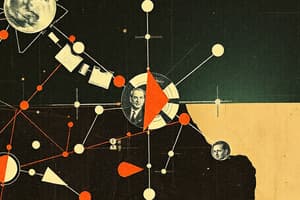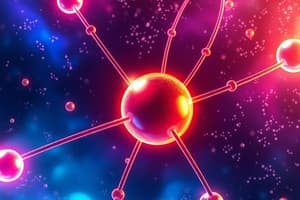Podcast
Questions and Answers
What is the relative mass of a proton in atomic mass units (amu)?
What is the relative mass of a proton in atomic mass units (amu)?
- 1.007276 (correct)
- 0
- 1.008665
- 5.485799 x 10^-4
Isotopes of an element have the same number of protons but different numbers of electrons.
Isotopes of an element have the same number of protons but different numbers of electrons.
False (B)
What is the charge of an electron?
What is the charge of an electron?
-1.602 x 10^-19 C
The atomic number (Z) of an element equals the number of ______ in the nucleus of its atoms.
The atomic number (Z) of an element equals the number of ______ in the nucleus of its atoms.
Match each particle with its corresponding charge:
Match each particle with its corresponding charge:
Which of the following statements is true regarding the mass number?
Which of the following statements is true regarding the mass number?
All naturally occurring carbon atoms have the same mass number.
All naturally occurring carbon atoms have the same mass number.
The mass number (A) of carbon with six protons and six neutrons is ______.
The mass number (A) of carbon with six protons and six neutrons is ______.
Which of the following equations correctly represents the relationship between wave speed, wavelength, and frequency?
Which of the following equations correctly represents the relationship between wave speed, wavelength, and frequency?
Electromagnetic waves travel at different speeds in a vacuum compared to in air.
Electromagnetic waves travel at different speeds in a vacuum compared to in air.
What is the speed of light in a vacuum in meters per second?
What is the speed of light in a vacuum in meters per second?
The energy emitted or absorbed in discrete quantities is referred to as a ___.
The energy emitted or absorbed in discrete quantities is referred to as a ___.
What type of radiation primarily reaches the Earth from the Sun?
What type of radiation primarily reaches the Earth from the Sun?
Match the type of radiation to its common use:
Match the type of radiation to its common use:
What was the frequency of the radio wave emitted by Ethiopian National Radio in kHz?
What was the frequency of the radio wave emitted by Ethiopian National Radio in kHz?
According to Planck's proposal, energy is emitted in ___ quantities.
According to Planck's proposal, energy is emitted in ___ quantities.
What law proposed by Dalton describes the relationship between masses of elements that combine chemically?
What law proposed by Dalton describes the relationship between masses of elements that combine chemically?
The photoelectric effect occurs when electrons are emitted from a metal surface due to electromagnetic radiation of any energy level.
The photoelectric effect occurs when electrons are emitted from a metal surface due to electromagnetic radiation of any energy level.
Name the three principal types of radiation emitted by radioactive substances.
Name the three principal types of radiation emitted by radioactive substances.
Bohr's theory explains that the electron in a hydrogen atom can only occupy specific ___ levels.
Bohr's theory explains that the electron in a hydrogen atom can only occupy specific ___ levels.
Match the following terms with their definitions:
Match the following terms with their definitions:
Which series in the hydrogen spectrum includes transitions to the n = 2 level?
Which series in the hydrogen spectrum includes transitions to the n = 2 level?
The emission spectrum of hydrogen only includes ultraviolet wavelengths.
The emission spectrum of hydrogen only includes ultraviolet wavelengths.
What does the Bohr Model primarily explain?
What does the Bohr Model primarily explain?
The transition from n = 4 to n = 1 in a hydrogen atom emits a photon in the __________ spectrum.
The transition from n = 4 to n = 1 in a hydrogen atom emits a photon in the __________ spectrum.
Match the following series in atomic hydrogen emission spectrum with their corresponding spectrum region:
Match the following series in atomic hydrogen emission spectrum with their corresponding spectrum region:
What factor increases as an electron transitions from a higher to a lower energy level in a hydrogen atom?
What factor increases as an electron transitions from a higher to a lower energy level in a hydrogen atom?
The Bohr Model accurately predicts the atomic spectra of all elements.
The Bohr Model accurately predicts the atomic spectra of all elements.
What is one limitation of the Bohr Model regarding spectral lines?
What is one limitation of the Bohr Model regarding spectral lines?
What does the periodic law state?
What does the periodic law state?
The electron configuration of an element can help determine its group in the periodic table.
The electron configuration of an element can help determine its group in the periodic table.
What is a 'group' in the context of the periodic table?
What is a 'group' in the context of the periodic table?
The first-row transition metal with atomic number 24 is __________.
The first-row transition metal with atomic number 24 is __________.
Which transition element is known for having a unique electron configuration due to a half-filled d-subshell?
Which transition element is known for having a unique electron configuration due to a half-filled d-subshell?
Match the following transition metals with their atomic numbers:
Match the following transition metals with their atomic numbers:
There are no exceptions to the Aufabu principle among transition metals.
There are no exceptions to the Aufabu principle among transition metals.
The electron configuration of Nickel can be represented as __________.
The electron configuration of Nickel can be represented as __________.
What does the letter 'd' represent in the subshell notation 4d?
What does the letter 'd' represent in the subshell notation 4d?
The value of ℓ can only be equal to or greater than the principal quantum number n.
The value of ℓ can only be equal to or greater than the principal quantum number n.
What is the maximum number of electrons that can occupy a subshell with ℓ = 1?
What is the maximum number of electrons that can occupy a subshell with ℓ = 1?
The magnetic quantum number (mℓ) can take values from _____ to _____ including 0.
The magnetic quantum number (mℓ) can take values from _____ to _____ including 0.
Match the principal quantum numbers with their allowed angular momentum quantum numbers (ℓ):
Match the principal quantum numbers with their allowed angular momentum quantum numbers (ℓ):
Which of the following statements is true regarding the electron spin quantum number (ms)?
Which of the following statements is true regarding the electron spin quantum number (ms)?
For every set of n, ℓ, and mℓ values, an atomic orbital can accommodate more than two electrons.
For every set of n, ℓ, and mℓ values, an atomic orbital can accommodate more than two electrons.
List the possible values of mℓ when ℓ = 2.
List the possible values of mℓ when ℓ = 2.
Flashcards
Proton
Proton
The positively charged particle found in the nucleus of an atom.
Neutron
Neutron
The neutral particle found in the nucleus of an atom.
Electron
Electron
The negatively charged particle that orbits the nucleus of an atom.
Atomic Number (Z)
Atomic Number (Z)
Signup and view all the flashcards
Mass Number (A)
Mass Number (A)
Signup and view all the flashcards
Isotopes
Isotopes
Signup and view all the flashcards
Isobars
Isobars
Signup and view all the flashcards
Isotones
Isotones
Signup and view all the flashcards
Wave Speed
Wave Speed
Signup and view all the flashcards
Hydrogen Spectrum
Hydrogen Spectrum
Signup and view all the flashcards
Balmer Series
Balmer Series
Signup and view all the flashcards
Speed of Light
Speed of Light
Signup and view all the flashcards
Electromagnetic Spectrum
Electromagnetic Spectrum
Signup and view all the flashcards
Quantized Energy Levels
Quantized Energy Levels
Signup and view all the flashcards
Electron Transitions and Photon Energy
Electron Transitions and Photon Energy
Signup and view all the flashcards
Continuous Spectrum
Continuous Spectrum
Signup and view all the flashcards
Planck's Quantum Theory
Planck's Quantum Theory
Signup and view all the flashcards
Limitations of the Bohr Model
Limitations of the Bohr Model
Signup and view all the flashcards
Quantum
Quantum
Signup and view all the flashcards
Bohr Model and Magnetic Fields
Bohr Model and Magnetic Fields
Signup and view all the flashcards
Bohr Model and Uncertainty Principle
Bohr Model and Uncertainty Principle
Signup and view all the flashcards
Quantum Energy and Frequency
Quantum Energy and Frequency
Signup and view all the flashcards
Wavelength, Frequency, and Speed of Light
Wavelength, Frequency, and Speed of Light
Signup and view all the flashcards
Lyman Series
Lyman Series
Signup and view all the flashcards
Law of Multiple Proportions
Law of Multiple Proportions
Signup and view all the flashcards
What is the nucleus?
What is the nucleus?
Signup and view all the flashcards
Electromagnetic radiation
Electromagnetic radiation
Signup and view all the flashcards
How can electromagnetic radiation be viewed?
How can electromagnetic radiation be viewed?
Signup and view all the flashcards
What is the photoelectric effect?
What is the photoelectric effect?
Signup and view all the flashcards
Principal Quantum Number (n)
Principal Quantum Number (n)
Signup and view all the flashcards
Angular Momentum Quantum Number (ℓ)
Angular Momentum Quantum Number (ℓ)
Signup and view all the flashcards
Magnetic Quantum Number (mℓ)
Magnetic Quantum Number (mℓ)
Signup and view all the flashcards
Electron Spin Quantum Number (ms)
Electron Spin Quantum Number (ms)
Signup and view all the flashcards
Quantum Numbers
Quantum Numbers
Signup and view all the flashcards
Subshell Notation
Subshell Notation
Signup and view all the flashcards
Electron Shell
Electron Shell
Signup and view all the flashcards
Electron Shell Capacity
Electron Shell Capacity
Signup and view all the flashcards
Periodic Law
Periodic Law
Signup and view all the flashcards
What is a group in the periodic table?
What is a group in the periodic table?
Signup and view all the flashcards
What is a period in the periodic table?
What is a period in the periodic table?
Signup and view all the flashcards
What are representative elements?
What are representative elements?
Signup and view all the flashcards
What are transition elements?
What are transition elements?
Signup and view all the flashcards
What are inner transition elements?
What are inner transition elements?
Signup and view all the flashcards
How does atomic radius vary in the periodic table?
How does atomic radius vary in the periodic table?
Signup and view all the flashcards
How does ionization energy vary in the periodic table?
How does ionization energy vary in the periodic table?
Signup and view all the flashcards
Study Notes
Atomic Structure and Periodic Properties of the Elements
- This unit covers the historical development of atomic models, experimental observations by scientists, subatomic particles, electromagnetic radiation, atomic spectra, Bohr models, quantum mechanical models, and periodic trends.
- The unit will also cover scientific inquiry skills.
- Early Greek philosophers debated the composition of matter. Democritus proposed the concept of atoms as indivisible particles.
- John Dalton developed an atomic theory based on experimental evidence.
- Dalton's postulates included: matter is made of atoms; atoms of an element are identical; atoms of different elements have different masses; atoms combine in simple whole number ratios to form compounds; and atoms are neither created nor destroyed during chemical reactions.
- Dalton's theory led to the development of the law of conservation of mass and the law of definite proportions.
- Dalton's theory was modified due to further scientific discoveries (the existence of isotopes and subatomic particles for example).
- The modern atomic theory and postulates are discussed.
- Key experiments leading to the discovery of the electron, nucleus, and neutron: cathode ray experiments, the oil drop experiment, and alpha particle scattering experiments.
- Specific discoveries and contributions by scientists like Thomson, Millikan, and Rutherford are mentioned.
- Atomic spectra are discussed: how atoms emit light when excited, how line spectra are discrete, and the connection to quantized energy levels.
- The Bohr model of the hydrogen atom is reviewed, highlighting its contributions and limitations including the postulates of quantized energy levels, circular orbits, and fixed angular momentum.
- Calculation examples that involve these equations are included. - The quantum mechanical model of the atom is explained, describing the quantum mechanical description of atoms.
- The roles of quantum numbers (n, l, ml, ms) and their significance in determining energy levels and orbital shapes are addressed.
- Specific orbital shapes of s, p, and d orbitals are discussed.
- Electronic configurations and orbital diagrams explaining the Aufbau principle, Hund's rule, and the Pauli exclusion principle.
- Periodic trends are discussed within the context of the periodic table.
- How the electron configuration of an element is related to its position in the periodic table is explained. - How to write electron configurations for elements in the periodic table.
- The concepts of atomic radius, ionization energy, electron affinity, electronegativity, and metallic character. Trends in these properties across periods and down groups are analyzed.
- The advantages of the periodic classification of elements are highlighted.
Studying That Suits You
Use AI to generate personalized quizzes and flashcards to suit your learning preferences.




